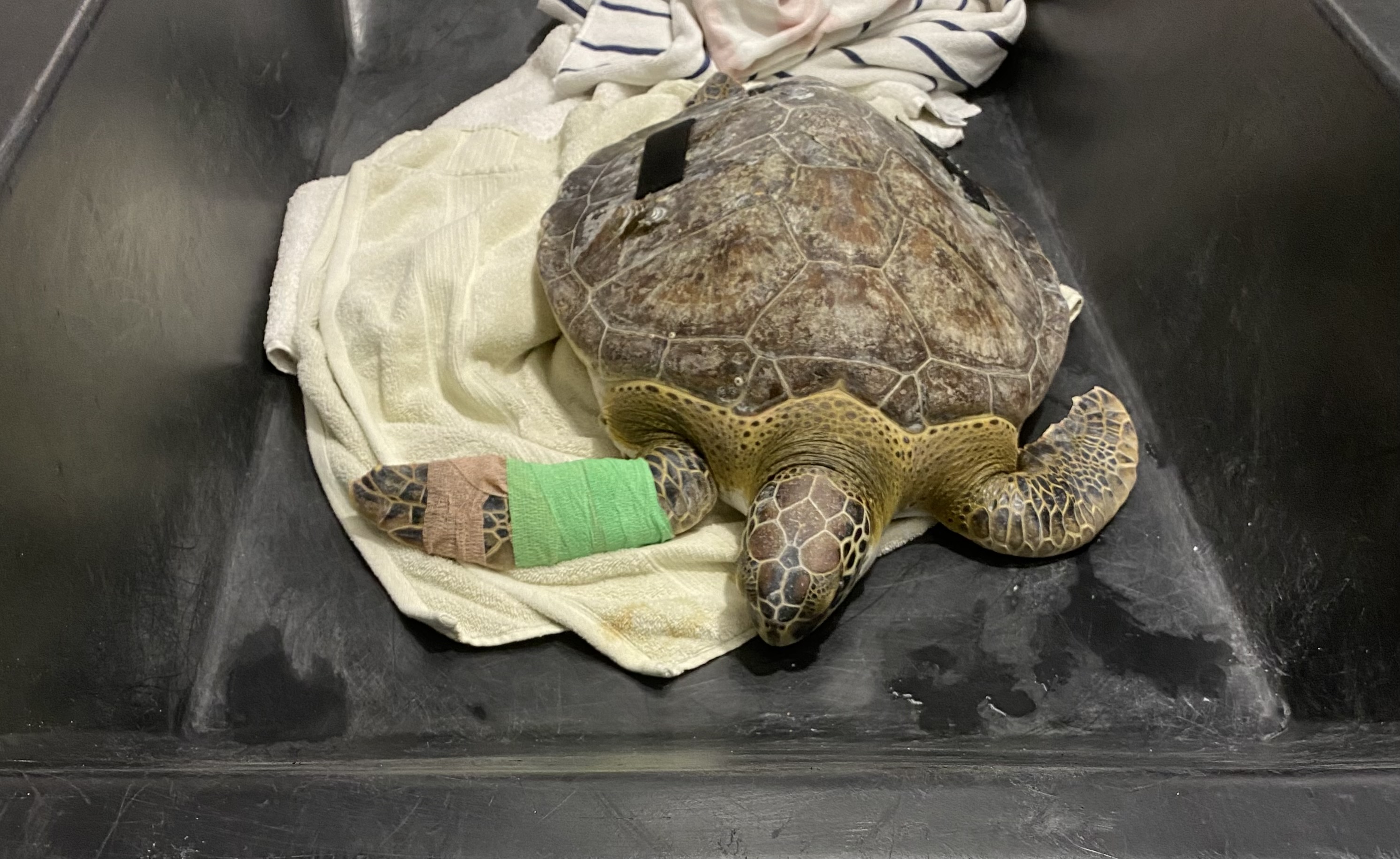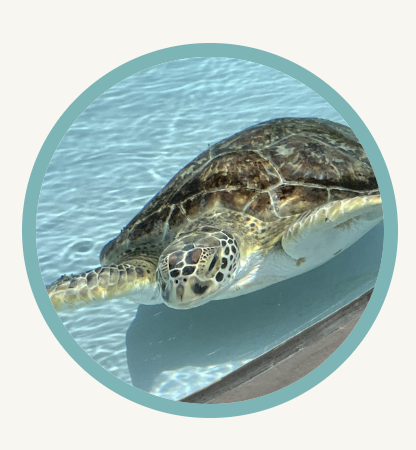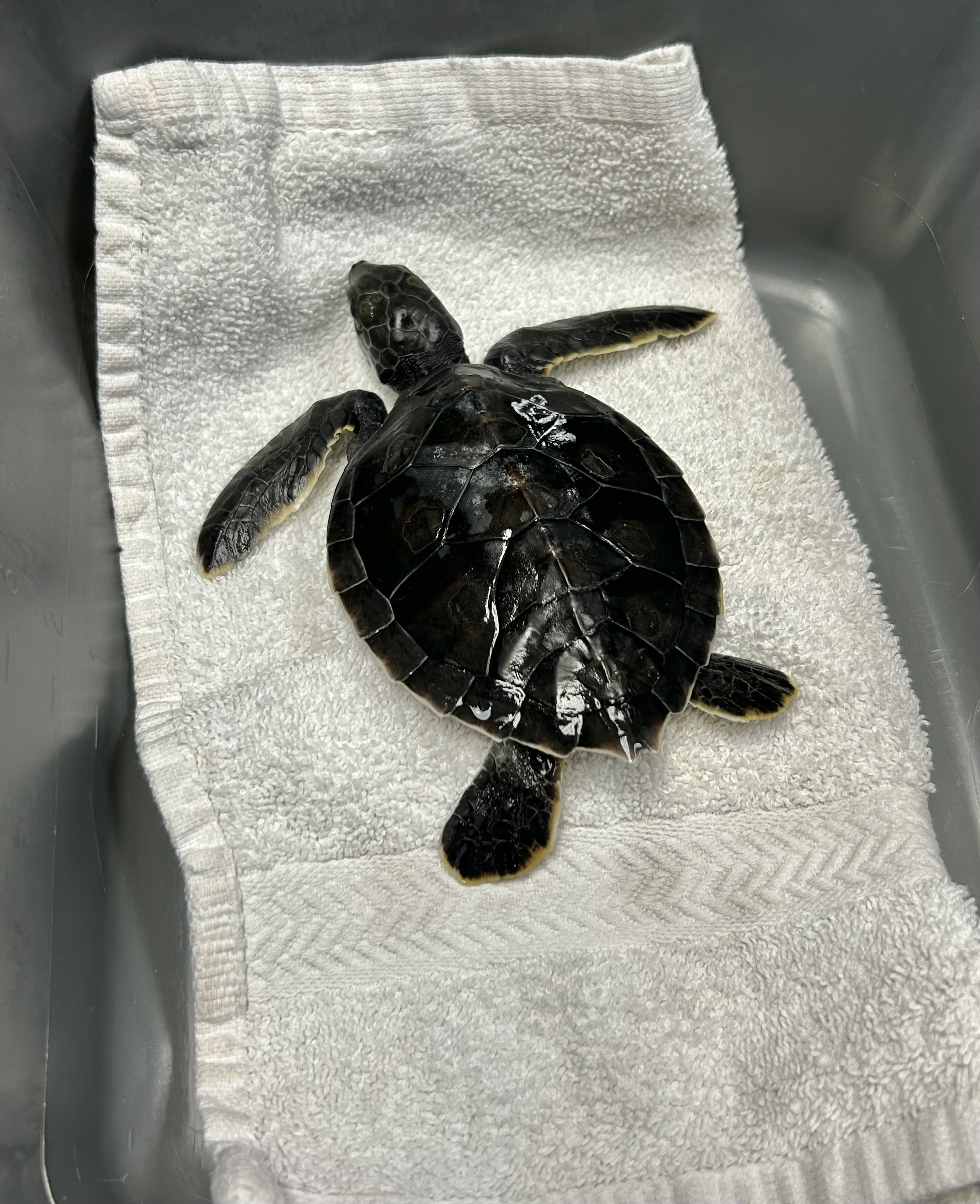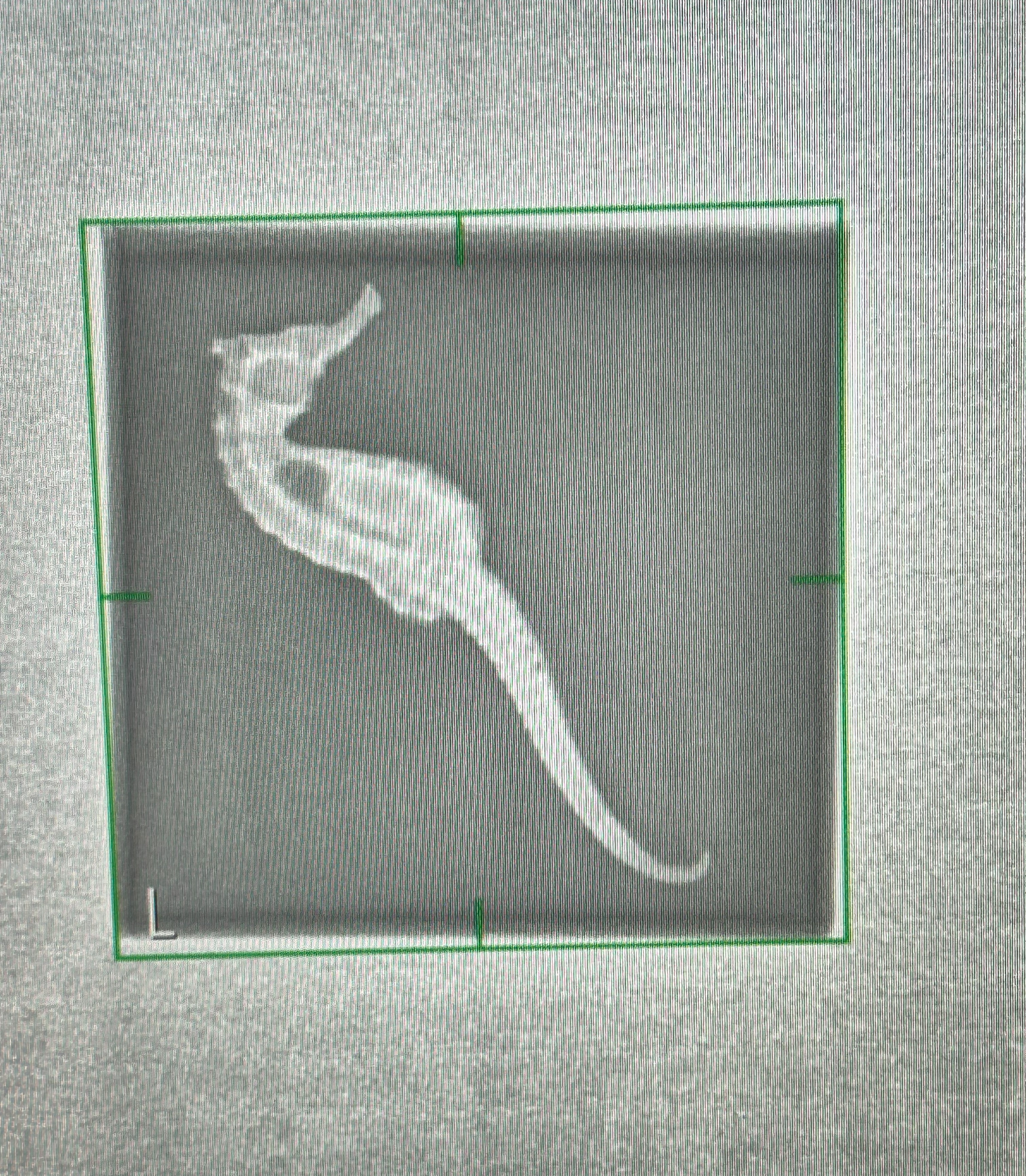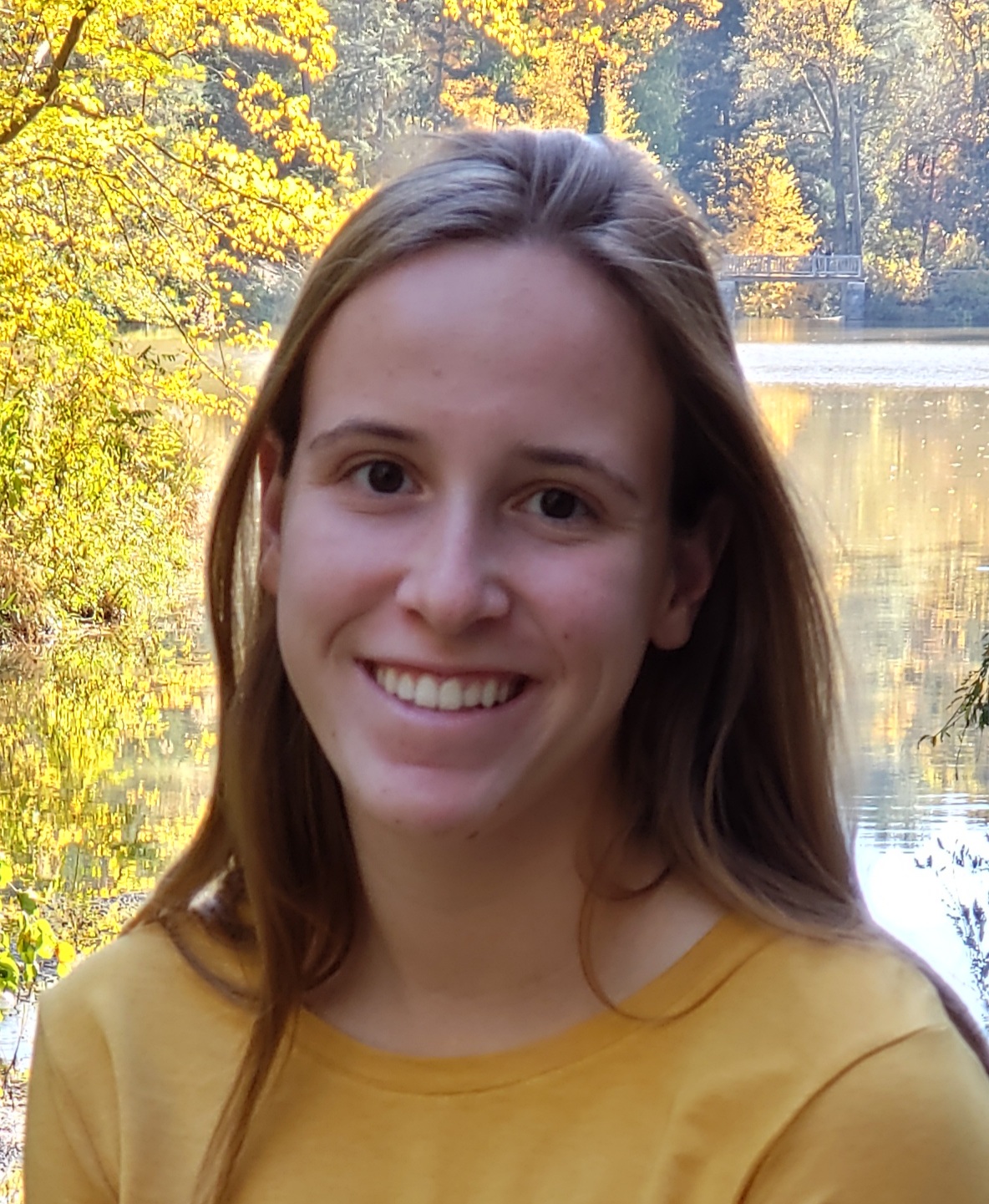From Tumors to Shark Attacks: Treating Sea Turtles at the Loggerhead MarineLife Center
By Madison Huber, Cornell DVM ‘26
I grab a pair of gloves from the hospital and walk out into the tank area. I am not sure why I put gloves on - 90% of the time they get soaked anyway. As I approach the tank, the other veterinary extern heads into the storage area to grab a net. Turns out there is no need. The turtle, a 15 kg green sea turtle named Holly, is swimming near the surface right by where I am standing. A rare occurrence, as her frequency of treatments means she has become quite averse to people. I use one hand to grab the front of her carapace, and the other to grab the back of the shell. My hands went deep enough that water rushed into the gloves. I pull the turtle out of the water, her flippers flapping wildly, and quickly place her in her bin. The visitors watched, some laughing as the front of my shirt got soaked by the saltwater splashing over my clothes. I picked up the bin and carried her into the hospital. The hospital technicians looked at my soaked shirt but said nothing. They had made jokes the first few times, but those jokes quickly became overused as they realized I spent far more of my time soaking wet than I ever did dry.
Three weeks prior, I had only glimpsed a sea turtle on one occasion. It was a trip to the New England Aquarium, where they had a sea turtle on display, but that was the closest I had ever come to the creatures. Now, I wash my hands, grab a new pair of gloves, and take a place beside one of the technicians as she supervises my administration of Holly’s intravenous medication.
The Loggerhead Marinelife Center is located in Jupiter, Florida. It was founded in 1983 to specialize in the rehabilitation and release of sea turtles. The facility is designed for South Florida; almost the entire facility is outside, covered by large awnings to protect the patients and guests from the sun. They devote a good portion of their efforts to education and outreach. Access to the facility is free, and the public has the ability to observe the rehabilitation tanks of stable patients. The hospital also provides public viewing via window observation, so that guests can observe treatments and surgeries as they occur.
The ultimate logic puzzle: developing treatment plans…and then changing them
During my four-week veterinary externship at the Loggerhead Marinelife Center, I worked under Dr. Heather Barron and her team of veterinary technicians. Occasionally, we would also have visiting veterinarians come for the day, such as Dr. Shelby Loos from the Gumbo Limbo Nature Center. Every morning, the externs received the treatment sheet for the day. We drew up the IV medications and partitioned the oral medications into the turtles’ respective pill bottles to be delivered to food prep. From there, the externs would talk amongst ourselves, developing the plan to approach treatments for the day. We would then confirm the plan with the technicians and they would give us feedback on our ideas, sometimes altering it slightly as patient care required. Each day was an ever changing logic puzzle, prioritizing the healthiest and youngest turtles’ treatments so as not to infect otherwise stable patients. We also had to plan when to drain certain tanks for certain treatments, trying to make the day as efficient as possible.
It was not uncommon to begin the afternoon and then have a stranded turtle delivered to the hospital, meaning we had to triage and reprioritize. Assessing a new patient and developing a treatment plan could take hours of our time. We tried to optimize our planned treatments while remaining prepared for the unknown.
Tumors take us from vet hospitals to human ones
Many of my mornings were spent in surgery. The most common surgeries that I observed were tumor removals and amputations. Fibropapillomatosis (more commonly referred to as FP) is caused by a herpesvirus that induces tumors in turtles. While the tumors are benign, these growths can hinder flipper movement during swimming and obstruct eyesight, while internal tumors can impair lung expansion and organ function. While the hospital chose not to pursue treatment of internal tumors due to poor prognosis, all turtles with external tumors underwent laser surgery to remove all visible tumors.
When a turtle arrived at the hospital with visible external tumors, a CT scan would be scheduled to evaluate the likelihood of internal tumors. Because Loggerhead Marinelife Center did not have a CT scanner, they developed a working relationship with Jupiter Hospital, a nearby medical facility to help conduct turtle CT scans. Dr. Fox, the M.D. radiologist, would give a preliminary evaluation of scans while Dr. Barron would look at the CT images in greater detail. I was fortunate enough to be present for three different CT scans. It was quite an experience wheeling a bin containing a sea turtle on a gurney through a human hospital. It always attracted a crowd, as the nurses and technicians always came by to catch a glimpse of the turtles.
Partial or full amputations were most common in turtles with shark-attack wounds or front flipper fractures. The procedure was standardized across patients, removing the affected portion of the limb and leaving as much remaining flipper as possible for continued function. During both the FP tumor removals and amputations, the externs would work together to administer and monitor anesthesia during the surgery. It was during these surgeries that Dr. Barron would run through her procedure, carefully explaining her surgery step by step. With her teaching skills, I felt like I was still at a teaching hospital.
Learning from others’ experience
During the routine injections when there were no wounds to clean or radiographs to take, or even on days when the veterinarian was not in the hospital, we would spend our time with the veterinary technicians. One of the technicians, Amy, had spent many years working in wildlife rehabilitation. With almost every procedure we did on our sea turtles, she would explain the similarities and differences between the handling and treatment of sea turtles, land turtles, birds, and other animals she had worked with in the past. Jaimie, who had experience working at several turtle hospitals, gave me tips on how to better and more easily hit a vein, give injections, and prepare blood smears for analysis. Tori and Marika walked the new externs through proper handling and showed us the differences in behavior of long-term patients, as some were more accepting of humans in close proximity to their tanks and others were more skittish. Even among sea turtles, there were some individuals predisposed to a stress response. Those patients were better kept in tanks away from the public.
It is one thing to be able to undertake a unique opportunity such as this and work in wildlife rehabilitation this early in my veterinary education; it is another to arrive at a facility where the hospital staff members take the time to walk you through how and why each procedure is done. On a slower day, two of the technicians walked us through a complete blood count (CBC) on a sea turtle, pointing out each cell type and its differences from what we were used to seeing in domestic animals. For every radiograph Dr. Barron evaluated, she explained what she was viewing. Dr. Shelby and the technicians, taking note of the fact that I was only a second-year veterinary student, would run through the anesthetic drugs, their mechanisms of actions, and reversals with me. I am incredibly grateful for both the lessons I learned and the kindness I received from the hospital staff during my time there. I would also like to thank Jake Holshuh ‘67, DVM ’69, who sponsored this experience through the Student Support Fund.
Madison Huber, Class of 2026, is a DVM student at the Cornell University College of Veterinary Medicine. Her interests include wildlife conservation, aquatics, and public health, especially in the context of how these topics relate to policy. She is a Health Professions Scholarship Program recipient who will enter the U.S. Army upon graduation. She hopes to combine her interests and practice veterinary medicine in a way that benefits both individual animals and the broader communities she will be working in.
Photos provided by Madison Huber.
Please consider giving to the Cornell Yang Center for Wildlife Health Student Support Fund to help provide more hands-on experiential learning opportunities for students passionate about wildlife health and conservation.

